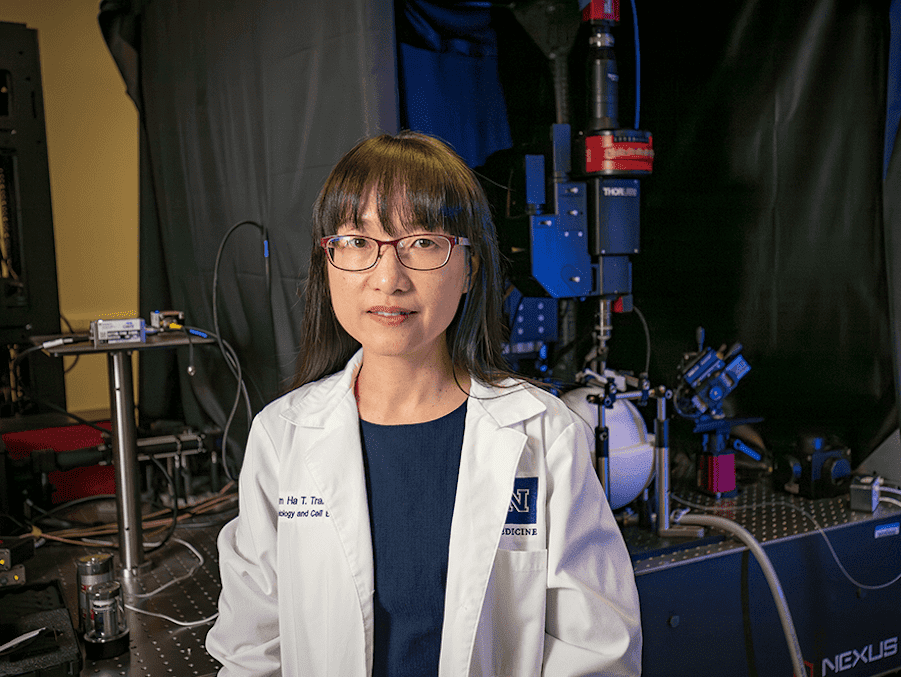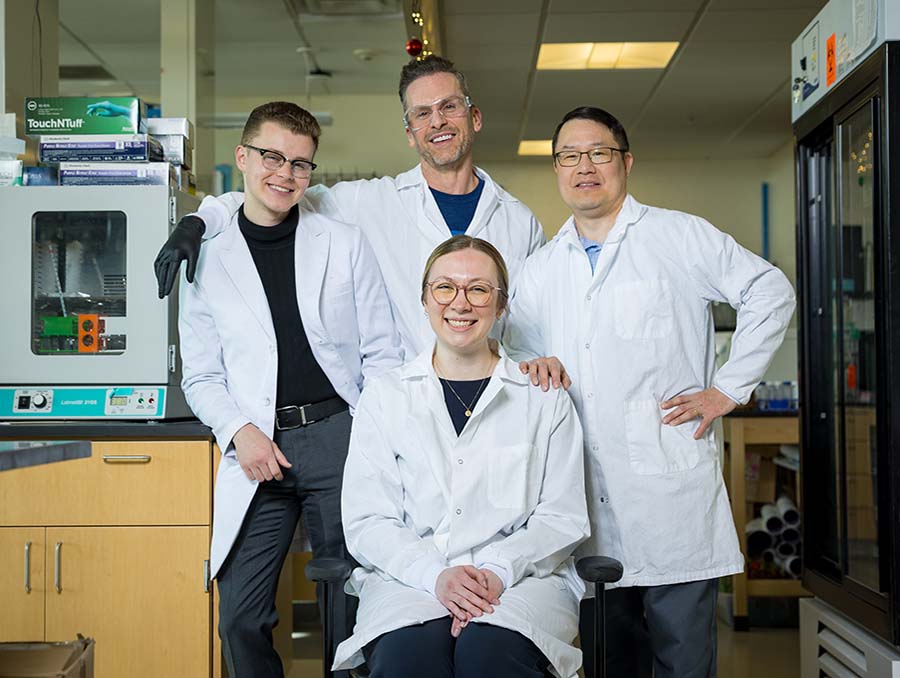What if we could better understand how the brain works by studying the relationship between neuronal activity and blood flow and potentially use that knowledge to create new therapies for neurological conditions like Alzheimer's and Parkinson's? That's precisely what Cam Ha Tran, Ph.D., an assistant professor in the department of cell biology and physiology at the University of Nevada, Reno School of Medicine (UNR Med), is investigating with more than $2 million in funding from the National Institutes of Health (NIH), including a prestigious Research Project Grant (R01)
The Tran Lab is studying how different brain cells communicate to regulate blood flow—more scientifically known as neurovascular coupling. A process in which the brain increases blood flow to localized regions to meet the energy demands imposed by increased brain activity, neurovascular coupling aims to ensure the brain has enough energy to perform the tasks it needs to do.
To understand the importance of neurovascular coupling, think of the brain as a bustling city with streets and highways carrying traffic in and out of different neighborhoods. Just as signals and signs regulate traffic, neurovascular coupling regulates blood flow in the brain to ensure the smooth delivery of oxygen and nutrients to different areas.
When neurovascular coupling is disrupted, it's like a traffic jam in the brain, with some areas getting too little oxygen and nutrients while others are flooded with too much. This can seriously affect brain health and function and contribute to neurological diseases like stroke, dementia, and Alzheimer's.
Answering some of the lesser-studied questions about why traffic jams happen in Brain City is the focus of the Tran Lab. "The brain is just 2% of our total body weight, but it requires a lot of energy to function, yet it doesn't have any energy reserves," Tran said. "Whatever energy it requires, it must get it directly from the blood vessels. The vessels are vital because they supply nutrients and take away waste, but what controls the vessel?"
Answering that question could have implications for developing treatments for degenerative brain diseases and common cognitive conditions associated with aging. Just as a city's traffic flow affects its overall health and functionality, neurovascular communication is critical to maintaining brain health and preventing disease. By understanding this complex process, scientists and researchers can potentially develop new therapies to support brain health.
Exploring the intricacies of the brain
Back in Brain City, well-timed traffic signals, roads are that wide-enough to handle rush-hour traffic, attentive, experienced traffic engineers, and electricity that powers the entire system keeps traffic flowing smoothly. Some of the key players are:
- Astrocytes used to be known as support cells—but now they appear to be involved in many processes. They are strategically positioned to communicate with both neurons and the vessels. Their role in regulating blood flow in the brain remains controversial, especially during a rise in neuronal activity.
- Neurotransmitters, such as serotonin, are traffic signals responsible for communicating with neurons, astrocytes, and blood vessels to modulate blood flow in response to changing demands.
- Vasoactivity refers to the ability of blood vessels to change their diameter in response to different signals to maintain a stable blood flow, like how lanes on a freeway may open depending on the traffic demands. Blood vessels include a network of arteries, arterioles, capillaries, venules, and veins.
- Calcium is vital for daily functions and acts as a second messenger to transmit important signals. It powers traffic signals and controllers like electricity and is critical for the communication between neurons, astrocytes, and blood vessels.
To study the intricate relationships between and unravel the mechanistic basis of these four factors and others, Tran and researchers use two-photon scanning fluorescence microscopy, electrophysiology, optogenetics, and chemogenetics to study neurovascular coupling in fully awake behaving animals.
NIH R01: A "serotonin boost" of scientific knowledge
Awarded in December 2021, Tran's R01 is the larger of Tran's two grants and will last five years while providing $2 million in funding. With the original and historically oldest grant mechanism used by the NIH to support health-related research and development, Tran and her team are studying the relationship between the neuron, astrocytes, and blood vessels and the role of serotonin in neurovascular coupling.
"There's a lot of information about serotonin because it's the oldest neurotransmitter," Tran said. "We know that serotonin can cause blood vessels outside of the brain to constrict, but we're not quite sure how serotonin affects blood vessels in the brain, especially small vessels."
Tran said preliminary data has shown that serotonin plays a role in modulating blood flow control in the brain, perhaps indirectly through astrocytes.
Calcium: It's not just for bones
Tran also received an NIH Exploratory/Developmental Research Grant Award (R21) in July 2021, which will conclude in July of this year. It provides $396,000 in funding to encourage exploratory or developmental research by providing support for the early and conceptual stages of project development.
With the R21 grant, the Tran Lab is studying how cerebral vascular changes (dilation, constriction, etc.) affect astrocytic calcium, neuronal calcium, or both and if that interaction is altered in normal aging. Calcium is involved in more physiological processes than bone health. It is a second messenger and critical in almost every physiological process.
When studying neurovascular coupling, Tran said people typically look to a unidirectional communication approach from neuron to astrocyte, then to the vessel, or from neuron directly to the vessel. But not many studies have investigated what happens to nearby neurons or nearby astrocytes as a vessel constricts and dilates.
Using Technology to Decode the Mysteries of the Brain
To study the intricate relationships between and unravel the mechanistic basis of brain cells, neurotransmitters, calcium, and vasoactivity, Tran and the researchers working with her use state-of-the-art technology, including:
- Two-photon scanning fluorescence microscopes
These powerful tools allow UNR Med's scientists to understand better the complex structures and processes that occur at the microscopic level. It uses high a power laser to create highly detailed, 3D images of cells and molecules moving and interacting in real-time in thick samples especially in live animals, which would not be possible by using other conventional fluorescence microscopes. It also can use different light colors to help distinguish between parts of a sample. - Electrophysiology studies
Researchers use specialized equipment to measure electrical activity in the brain or other body parts to study how different cells and tissues communicate. They can use this information to study the effects of various stimuli, such as drugs or environmental factors, on the body's electrical signals. - Optogenetics
This neuroscience research technique uses light to control the activity of specific cells in the brain. Scientists use genetic engineering to insert light-sensitive proteins into brain cells. Then, they use a light source to activate or inhibit these cells, allowing them to study the effects on behavior and brain function. It's like using a remote control to turn specific brain cells on or off, allowing scientists to understand how different cells contribute to specific brain functions. - Chemogenetics
By using chemicals to control the activity of specific cells in the brain or other organs with a high degree of precision, researchers can "turn on" or "turn off" specific cells and investigate their function.
Real-time, Real-life Research
Tran's research is inspired by the data she gathered while studying brain blood flow regulation in completely awake mice as a postdoctoral fellow at the University of Calgary.
"While studying vascular biology, I came across neurovascular coupling, and I thought, ‘Why don't we study that?'" she said. "We can't study the vessel in isolation, and I have always been interested in studying the whole organism."
Following that line of thought, Tran began developing her awake in vivo research techniques using references from other labs also pursuing the approach. Unlike studying cells extracted from a subject and placed in isolation like in a petri dish, in vivo awake research allows scientists to see different responses to stimuli in real time.
During in vivo awake research, mice are fully conscious and free to move. They are typically trained to perform specific tasks or behaviors, such as navigating a maze or responding to a stimulus, while their physiological responses are measured. Without anesthesia or other drugs, researchers can better understand how biological systems function in their whole and natural states.
Animals are only involved in research at the University of Nevada, Reno, when there are no alternatives. All animal research is done ethically and humanely, keeping with the Association for Assessment and Accreditation of Laboratory Care standards, which the University most recently received full reaccreditation in 2022.
"As researchers, we have a responsibility to uphold high standards for animal welfare," Tran said. "We work diligently to ensure that the animals involved in our research are treated with the utmost care and respect."
Studying brain cells and related functions is critical for developing treatments for neurological disorders. In vivo awake research is a preferred approach because it provides essential insights into how the brain works in a natural state, Tran added.
"Truly understanding these pathways can provide useful information for reducing neurodegenerative consequences," Tran said.
The University of Nevada, Reno School of Medicine (UNR Med), Nevada's first medical school, is a community-based, research-intensive medical school with a statewide vision for a healthy Nevada. Established in 1969, UNR Med is improving the health and well-being of all Nevadans and their communities through excellence in student education, postgraduate training and clinical care, research with local, national, and global impact, and a culture of diversity and inclusion. For more information, visit med.unr.edu.















